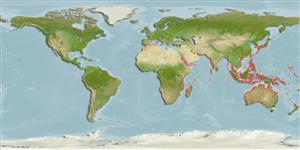Perinereis nuntia (Savigny, 1818)
Bar-toothed nereid| Native range | All suitable habitat | Point map | Year 2050 |

|
| This map was computer-generated and has not yet been reviewed. |
| Perinereis nuntia AquaMaps Data sources: GBIF OBIS |
Upload your photos
Google image |
No photo available for this species.No drawings available for Nereididae.
Google image |
No photo available for this species.
Classification / Names Common names | Synonyms | CoL | ITIS | WoRMS
| Phyllodocida | Nereididae
Environment: milieu / climate zone / depth range / distribution range বাস্তুসংস্থান
; গভীরতার পরিসীমা 0 - 4 m (Ref. 114654). Tropical
বিতরণ দেশ সমূহ | এফ এ ও এলাকাসমূহ | বাস্তুতন্ত্র | দৃষ্টিগোচর | প্রচলন
Indo-West Pacific and the Mediterranean Sea. Tropical and subtropical.
Length at first maturity / আকৃতি / ওজন / Age
Maturity: Lm ? range ? - ? cm
Common in intertidal and shallow marine waters (Ref. 107800). Members of the genus Perinereis are found in intertidal mud flats, a source of food for wading birds and fish (Ref. 86799). Probably omnivores and scavengers as some species have been observed feeding on algae while others feed on invertebrates (e.g. ascidians) and carrion (Ref. 107862).
Life cycle and mating behavior পরিপক্কতা | প্রজনন | ডিম ছাড়া | ডিমসমূহ | ডিম্বধারন ক্ষমতা | শুককীট
Members of the class Polychaeta are mostly gonochoric (sexual). Mating: Females produce a pheromone attracting and signalling the males to shed sperm which in turn stimulates females to shed eggs, this behavior is known as swarming. Gametes are spawned through the metanephridia or body wall rupturing (termed as "epitoky", wherein a pelagic, reproductive individual, "epitoke", is formed from a benthic, nonreproductive individual, "atoke"). After fertilization, most eggs become planktonic; although some are retained in the worm tubes or burrowed in jelly masses attached to the tubes (egg brooders). Life Cycle: Eggs develop into trocophore larva, which later metamorph into juvenile stage (body lengthened), and later develop into adults.
Main reference
সূত্র সংখ্যা | সমম্বয়কারী | সহযোগী
Wehe, T. and D. Fiege. 2002. (Ref. 2663)
IUCN Red List Status (Ref. 130435)
CITES status (Ref. 108899)
Not Evaluated
CMS (Ref. 116361)
Not Evaluated
Threat to humans
Harmless
Human uses
| FishSource |
হাতিয়ার
আরো তথ্য
প্রচলিত নাম সমূহ
প্রতিনাম সমূহ
শিকারী প্রাণী সমূহ
প্রজনন
পরিপক্কতা
ডিম ছাড়া
ডিম্বধারন ক্ষমতা
ডিমসমূহ
Egg development
প্রতিনাম সমূহ
শিকারী প্রাণী সমূহ
প্রজনন
পরিপক্কতা
ডিম ছাড়া
ডিম্বধারন ক্ষমতা
ডিমসমূহ
Egg development
Age/Size
বৃদ্ধি
Length-weight
Length-length
বহিঃ অঙ্গ সংস্থান
শুককীট
প্রাচুর্য
বৃদ্ধি
Length-weight
Length-length
বহিঃ অঙ্গ সংস্থান
শুককীট
প্রাচুর্য
ইন্টারনেট সুত্র
BHL | BOLD Systems | CISTI | DiscoverLife | FAO(Publication : search) | Fishipedia | GenBank (genome, nucleotide) | GloBI | Gomexsi | Google Books | Google Scholar | Google | PubMed | জীবন বৃক্ষ | Wikipedia (Go, অনুসন্ধান ) | জুলজিকাল রেকর্ড
Estimates based on models
Preferred temperature
(Ref. 115969): 21.8 - 29.3, mean 28.5 (based on 2717 cells).


